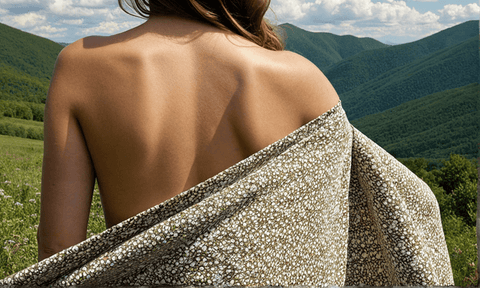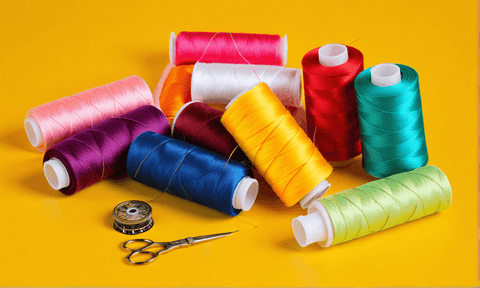
Choosing your fabric: The keys to a perfect choice
Share
Whether you are a beginner or an expert in sewing, one question remains fundamental: "But which fabric should you choose?" Faced with the plethora of fabrics available on the market, how can you find your way? What considerations should guide your selection to arrive at the optimal choice? In this guide, we will explore the various aspects to consider when selecting fabric, accompanied by practical advice on the types of garments to create with each material. Let's go!

The essential questions to ask yourself
Choosing the right fabric is a crucial step that greatly determines the success of your project . To help you navigate through this sea of possibilities, let's take a closer look at the essential questions to ask yourself to make the best possible choice . With the answers you get, you'll refine your choices and ensure that your creation perfectly reflects your expectations .
1. Who do you reserve your creation for?
The first question to consider is: “ Who is my piece for? ” Is it a personal creation, a gift for a loved one, or perhaps a piece intended for sale? Determining the recipient influences the choice of style, size, and type of fabric to ensure complete satisfaction. It is therefore important to consider the personal preferences, tastes, and needs of the person who will receive your beautiful creation. Additionally, whether the piece is intended for a man, woman, or child can also influence the design, colors, and even patterns chosen. For example, a piece for a child could feature playful patterns, while a creation intended for an adult could favor more subdued tones and more elegant patterns.
2. What is the fabric intended for?
It is then essential that you clearly define the intended use of the fabric . Is it a casual garment, a formal piece, a sports project, or perhaps a piece of furniture? The nature of the object directly impacts the type of fabric to be favored, depending on its own characteristics.
3. When will my creation be worn?
Another crucial aspect to consider is to anticipate the season in which your creation will be worn , which will help you narrow down your selection. Lightweight and breathable fabrics are ideal for summer, while heavier and more insulating textiles are better for winter. However, it is important to note that this is a general rule; it is entirely possible to wear lighter outfits even in winter.

4. Does the project require specific elements (stretch, waterproofing, etc.)?
Next, evaluate the specific needs of your project. If specific features such as stretch, waterproofing, or other special properties are required, make sure the fabric you choose offers them.
5. What type of tissue to target?
Once all this is done, it is time to explore the wide range of fabrics available on the market. Cotton, linen, polyester, viscose, silk … Each type of fabric offers unique properties. To guide you in your research, let’s start by distinguishing two main categories of fabrics: natural fabrics and synthetic fabrics .
Natural fabrics, made from plant or animal fibers, have notable advantages such as breathability, softness and the ability to absorb moisture . Cotton, for example, is appreciated for its comfort and versatility, while linen offers a summery lightness and a distinctive texture.
On the other hand, synthetic fabrics like polyester are often chosen for their durability, wrinkle resistance, and ease of care . These fabrics may also offer specific properties, such as water or stain resistance, making them more suitable for certain types of projects.
For an in-depth exploration, we recommend reading our article on the different types of fabrics .
6. What is your fabric budget?
Now that you know what fabric to choose, it's time to set a realistic budget for your project . While we all want to start with an unlimited budget, this will help you set clear boundaries while guiding you toward fabric options that fit your budget. The diversity of fabrics generally means that you can find quality options at all price points.
With us, you will find a selection of quality fabrics at exceptional prices . Indeed, our fabrics come from end of series , which makes them limited and very qualitative pieces. Take advantage of this opportunity to realize your projects while benefiting from high quality products at super advantageous prices.
7. Desired certifications
If you attach particular importance to criteria such as ecology or safety, do not forget to look for certified fabrics . It will be quite easy to locate them, renowned labels such as the GOTS (Global Organic Textile Standard) or OEKO-TEX® label guarantee textiles free of harmful substances, thus offering peace of mind during creation.
As explained above, our fabrics come from end-of-line products, which is part of a zero waste approach. This naturally contributes to a more ecological and responsible approach, which is particularly essential in our times.
8. Are there any allergic constraints or sensitivities to the fabric?
Finally, if your creation is intended for direct contact with the skin, take into account possible allergies or sensitivities . Opt for hypoallergenic and soft fabrics to guarantee optimal comfort for the person who will wear your creation.
By asking yourself these few questions, you will not only be able to filter your options methodically, but also ensure that your choice is informed and aligned with the requirements of your sewing project.

Which garment to sew with which fabric?
If you have absolutely no idea to start with and you feel lost in this ocean of possibilities, we offer you a small list of clothing sewing projects . These are classified by level of difficulty, you will also find the fabrics most often used for these creations .
Easy Projects
Tote bag
The tote bag is a simple and practical project, ideal for carrying your daily belongings. It can be made of cotton or sturdy canvas to ensure its durability. Don't hesitate to add an inside pocket to make it more practical and personalize it with patterns or embroidery. 
Makeup remover wipe
Washable makeup remover wipes are an eco-friendly and economical alternative to disposable cotton pads. They can be made from fabrics such as organic cotton , to take care of your skin while respecting the environment. Start with squares of a practical size and overlock the edges to prevent them from fraying.

Kit
The pencil case is a versatile accessory, ideal for storing your makeup products, office supplies or small everyday items. It can be made of coated fabric to make it water-resistant and easy to clean. If you are more experienced, do not hesitate to add a zipper or a button placket to secure its contents, and personalize it with embroidery or appliques to make it totally unique.

Projects of medium difficulty
Swimwear
Swimsuit making is a challenging but very rewarding project! Choose swim-friendly fabrics, such as lycra or nylon , and make sure to use chlorine-resistant threads. Swimsuits can be customized with details such as ruching, ruffles or cutouts depending on your skill level.

The jean
Sewing jeans can be a bit tricky, but once you’re done, you can wear them all year round. Denim fabric is perfect for this project. Its strength and distinctive texture make it an ideal choice for creating a durable and long-lasting piece. With denim, you can play with different shades of blue and even experiment with washed finishes.

Shirts
Making shirts requires some precision but is still completely accessible to intermediate seamstresses. Lightweight fabrics like cotton or linen will allow you to make comfortable and breathable shirts. Just make sure you have mastered the techniques of sewing cuffs, collars and buttonholes for a top result.

Advanced Projects
Leather handbag
Making a leather handbag is a more complicated project but one that is very satisfying once completed. You can choose different types of leather depending on the desired look and durability , such as cowhide for its strength or lambskin for its suppleness. The sewing techniques specific to leather and the handling of accessories such as clasps and handles will require some expertise.
As a quick aside for those who want to start making a handbag, we highly recommend checking out the BAGS & PIECES website. Their custom DIY boxes include everything you need, from cutting out the pieces to the final stitching, to create your own leather bag.

Structured coat
Making a structured coat requires a good command of advanced sewing techniques. You can opt for fabrics like wool or tweed to create an elegant silhouette. Details like buttons, pockets and linings will greatly contribute to the success of your coat.

Tailored suit
Tailoring a tailored suit is a sewing challenge that requires both precision and craftsmanship. You will need to work with quality fabrics such as virgin wool or a wool blend to ensure a perfect fit. The construction of the jacket and pants as well as the adjustments to achieve a tailored fit will require some expertise.

Here we are at the end of our article dedicated to choosing your next fabric . We hope you enjoyed it and we look forward to seeing you very soon for other exciting articles!



